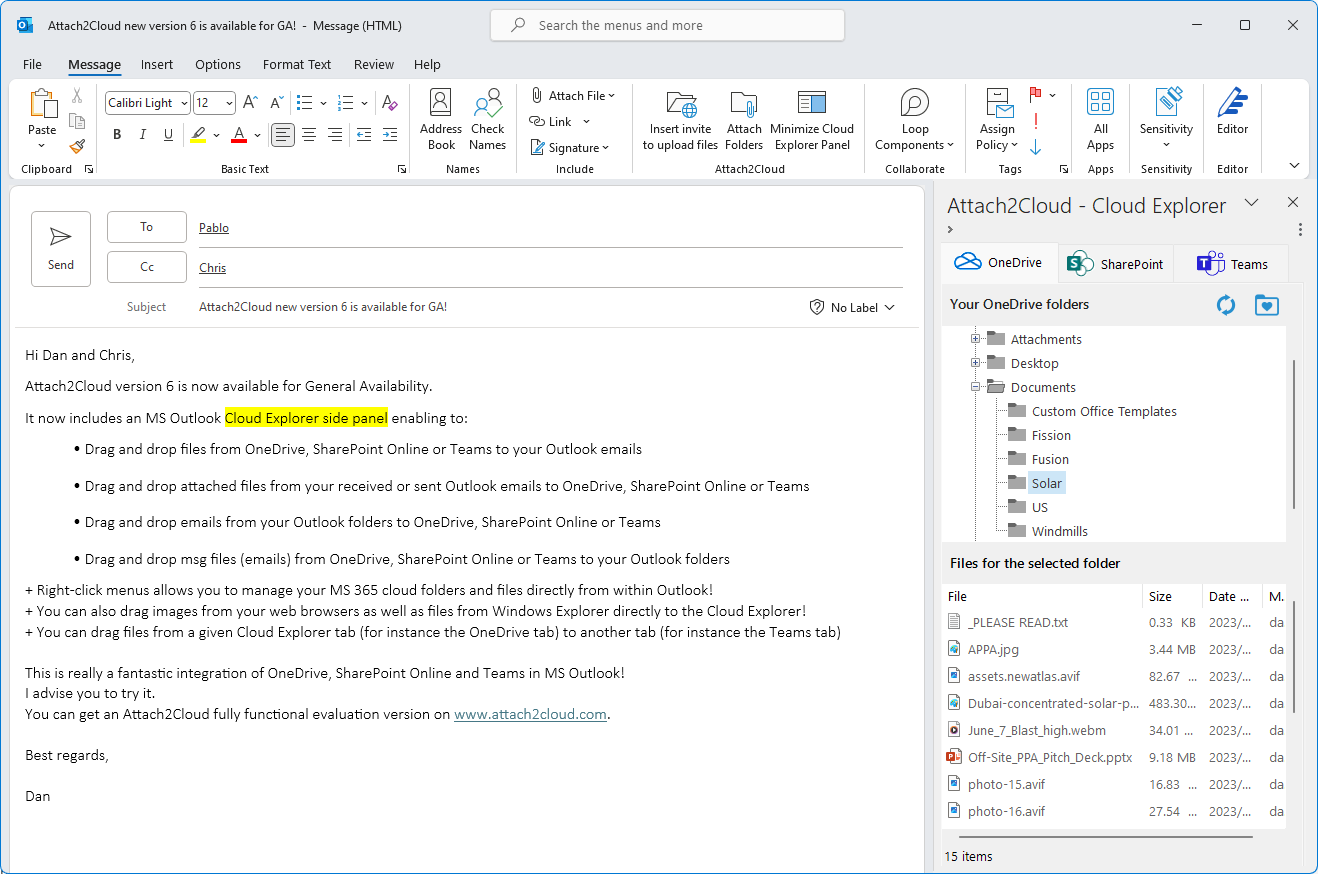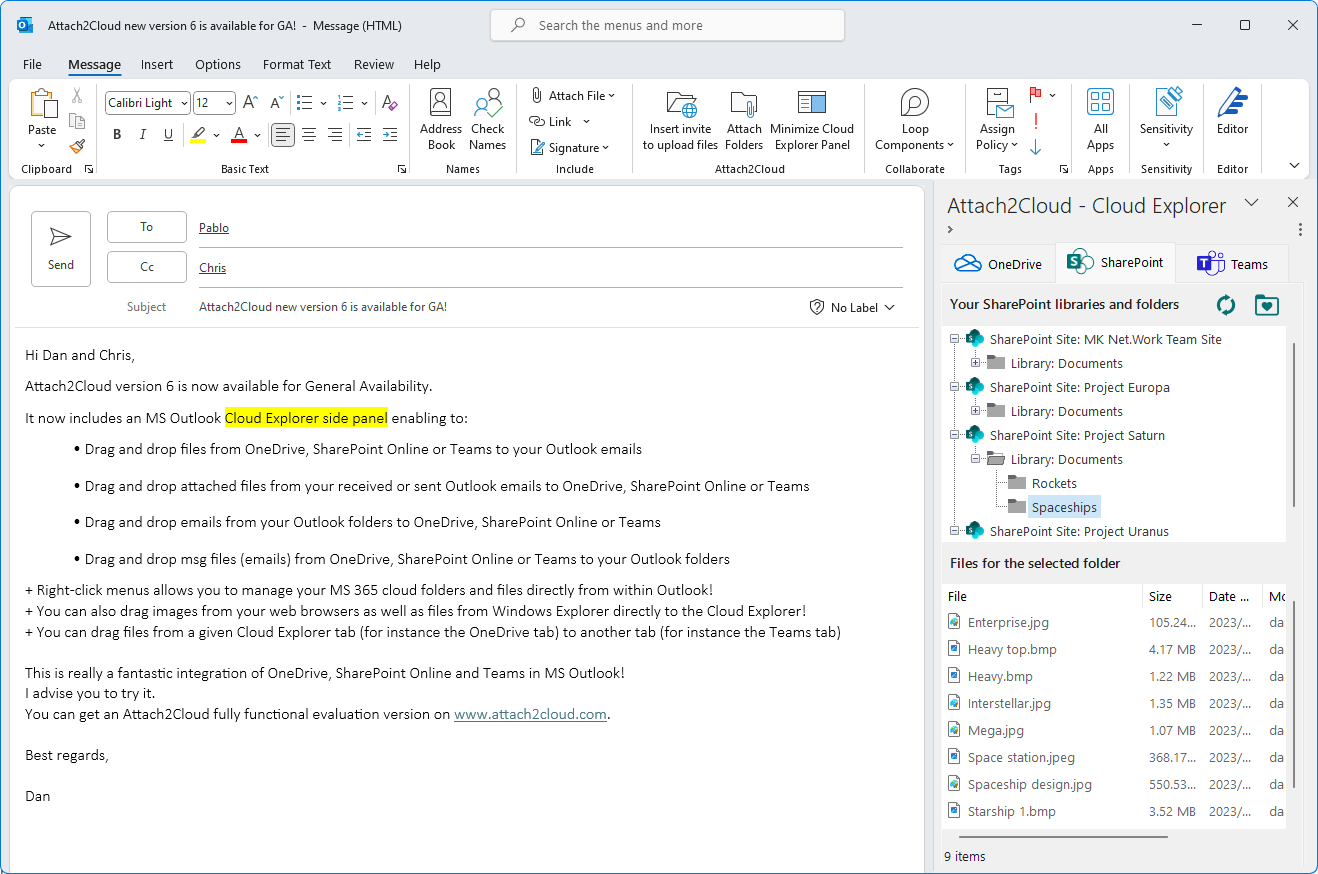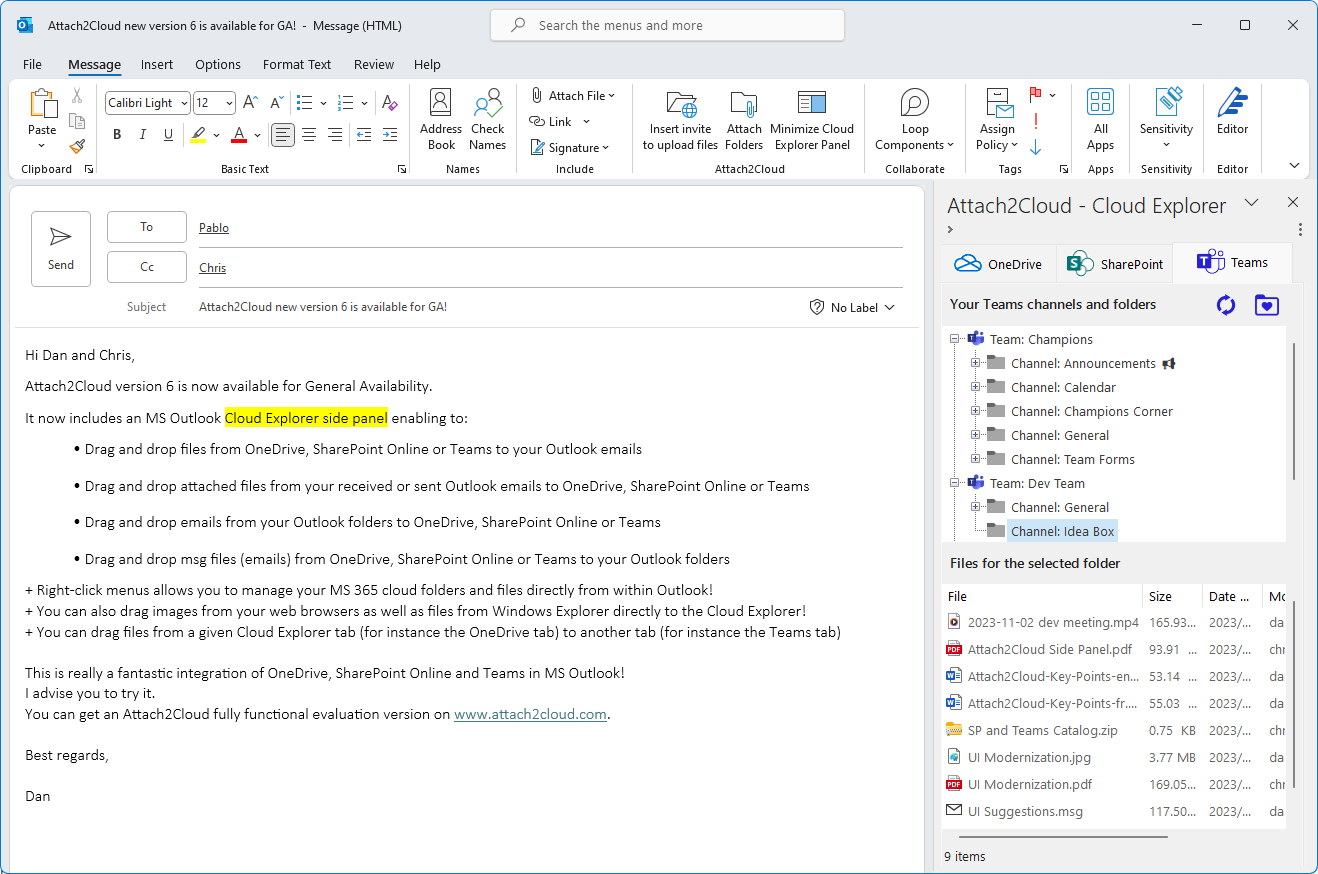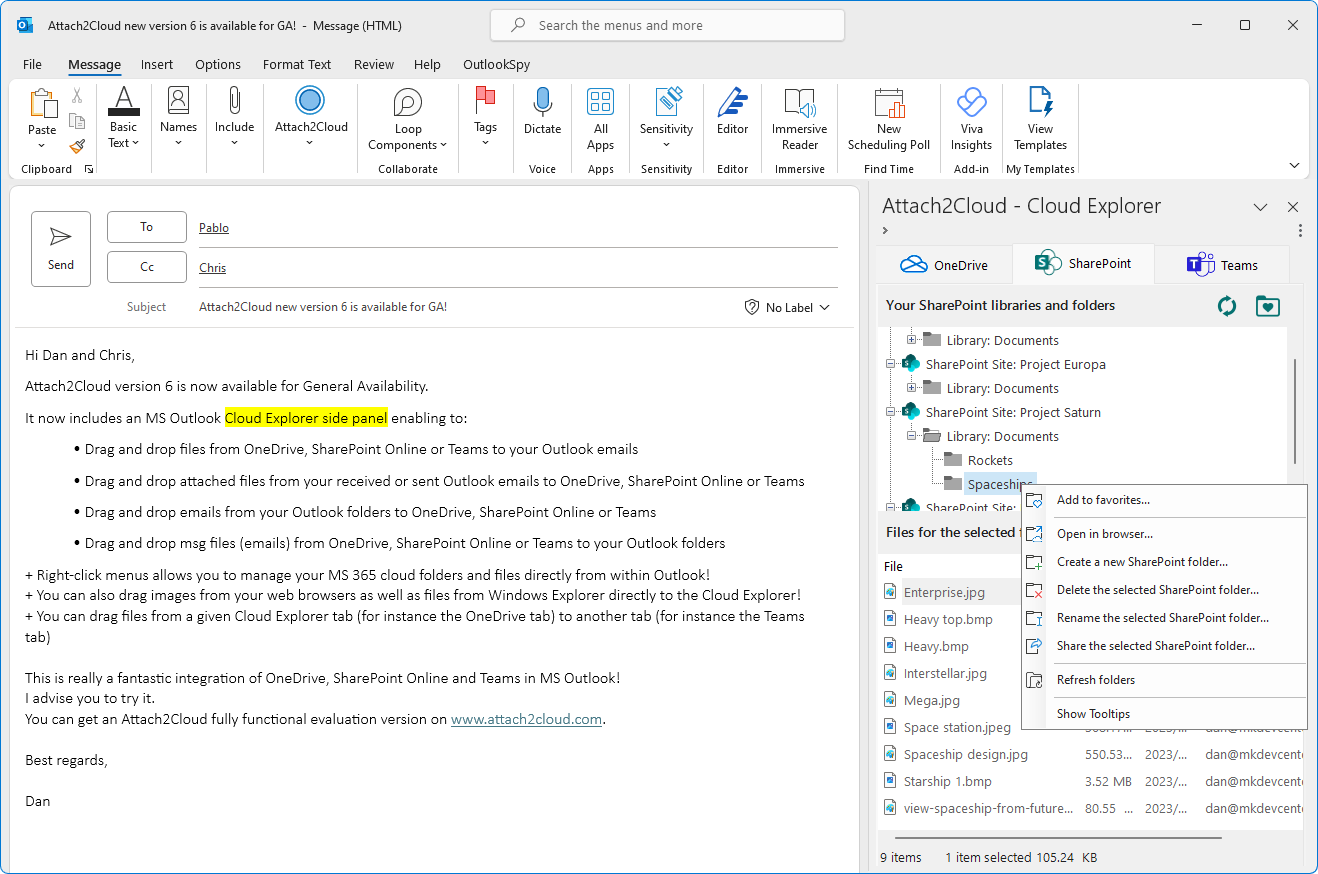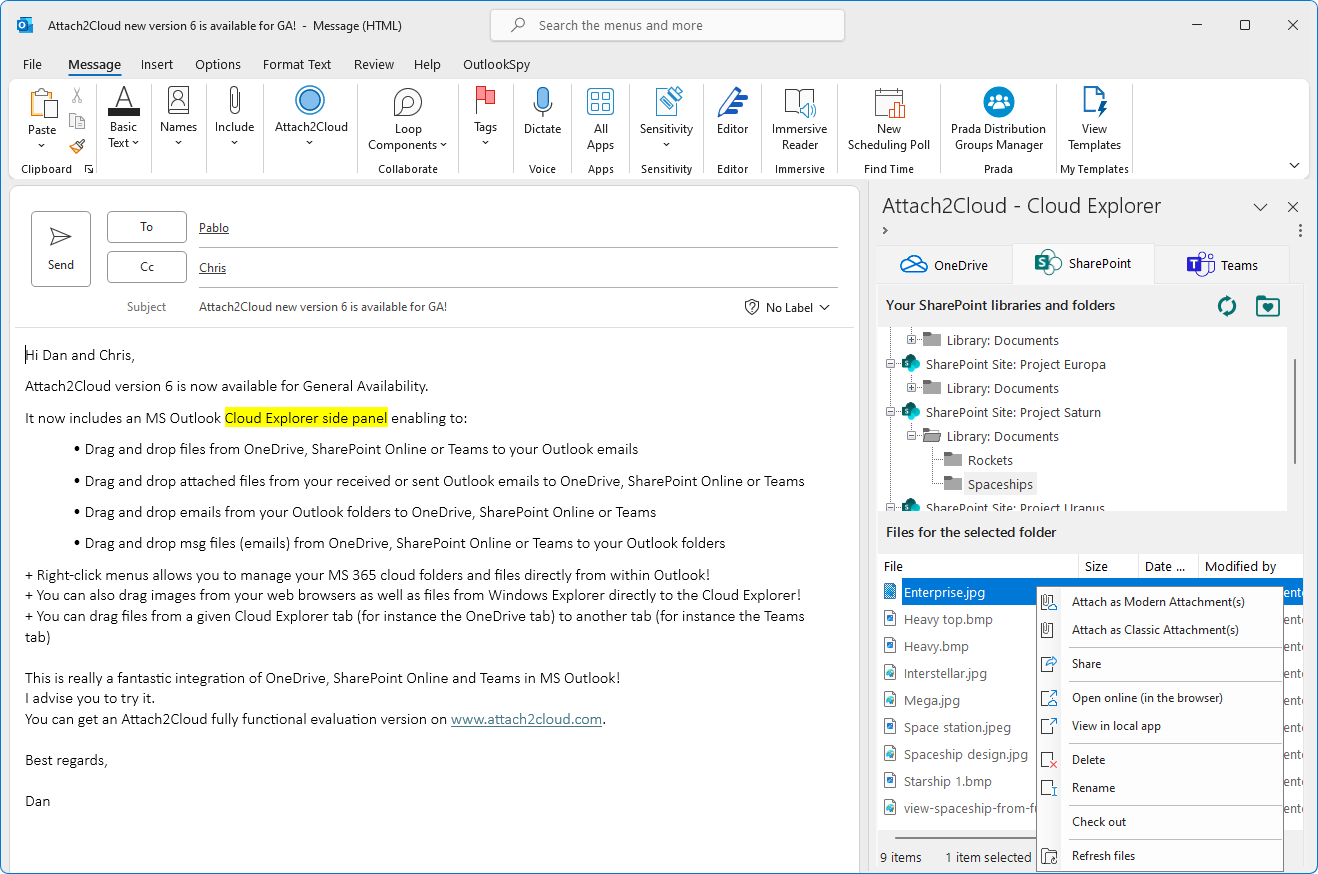
Cloud Explorer for Microsoft Outlook
Explore your MS 365 cloud storage spaces directly from Microsoft Outlook.
With the Cloud Explorer for MS Outlook, Explore your MS 365 cloud storage spaces (OneDrive, SharePoint Online and Teams) directly from Microsoft Outlook
Attach2Cloud V6 provides a Cloud Explorer for Microsoft Outlook under the form of an MS Outlook (collapsible / expansible) Side Panel:
The Cloud Explorer of Attach2Cloud V6 provides
full support of bi-directional drag-drop
between your MS 365 cloud storage spaces
(OneDrive, SharePoint Online and Teams)
and MS Outlook
Cloud Explorer - Drag and drop supported actions - Part 1
Attach cloud files to your MS Outlook emails
Drag and drop cloud files from the Cloud Explorer OneDrive, SharePoint Online and Teams panels to your MS Outlook emails being edited to attach them as Modern or Classic attachments.
Save files attached to received and sent MS Outlook emails to the Cloud
Drag and drop files attached to your received and sent MS Outlook emails to the Cloud Explorer OneDrive, SharePoint Online or Teams tabs to store them on these cloud platforms.
Save Outlook emails to the Cloud
Drag and drop MS Outlook emails from your MS Outlook folders to the Cloud Explorer OneDrive, SharePoint Online or Teams tabs to store them as .MSG files on these cloud platforms.
Import emails from the Cloud to MS Outlook
Drag and drop MSG files from the OneDrive, SharePoint Online and Teams Cloud Explorer tabs to your MS Outlook folders to import them as messages in these folders.
Cloud Explorer - Drag and drop supported actions - Part 2
Create an email and attach the selected cloud files to it
Drag cloud files from the Cloud Explorer OneDrive, SharePoint Online or Teams tabs and drop them to the MS Outlook window to create a new email containing the dropped files attached as modern or classic attachments.
Copy cloud files from one cloud platform to another
Drag cloud files listed in the Cloud Explorer OneDrive, SharePoint Online and Teams tabs and drop them to another Cloud Explorer tab to copy them for example from OneDrive to SharePoint. The file copy occurs fully in the cloud. This means that if you drag and drop multi-gigabyte files, the copy is almost instant (because the files are not downloaded on your PC and uploaded again to the cloud).
Copy local files and folders to the Cloud
Drag and drop files or even entire folders from Windows Explorer to the Cloud Explorer OneDrive, SharePoint Online and Teams tabs to copy them on these cloud platforms.
Save pictures displayed in your web browser to the Cloud
Drag and drop pictures displayed in your web browser to the Cloud Explorer OneDrive, SharePoint Online and Teams tabs to store them (as files) on these cloud platforms. (And use the Cloud Explorer right-click + Rename menu on these files to give them a file name of your choice).
The Cloud Explorer right-click menus enable you to interact with, and manage your OneDrive, SharePoint Online and Teams files and folders, directly from Microsoft Outlook.
With the Cloud Explorer for Microsoft Outlook, you can now share, open, rename, and delete your MS 365 cloud files and folders, create new cloud folders, manage favorite cloud folders, and even more, right from Microsoft Outlook!
Right-click menus on
Cloud Explorer Files
Cloud Explorer right-click menus - On files
Right-click + Share
Right-Click + Share on any cloud files displayed in the Cloud Explorer OneDrive, SharePoint Online or Teams panels to create a new MS Outlook email containing the selected files attached as Modern Attachments.
Right-click + Open
Right-click + Rename
Right-click + Delete
Right-click + Check out / in
Right-click + Check out on any selection of files listed in the SharePoint Online or Teams tabs to check out these files.
Right-click + Check-in on previously checked out files to check them in.
right-click + Cancel check-out on previously checked out files to cancel their check out.
Files checked out by you are highlighted in light red. Files checked out by others are highlighted in red.
Right-click + Refresh
Right-click menus on
Cloud Explorer Folders
Cloud Explorer right-click menus - On folders
RIght-click + Share
Right-click + Share on any cloud folder displayed in the Cloud Explorer OneDrive, SharePoint Online or Teams tabs to create a new MS Outlook email containing a sharing link to this cloud folder. (A panel enables to select the sharing permission).
Right-click + Open Online
Right-click + Open online on any cloud folder displayed in the Cloud Explorer OneDrive, SharePoint Online or Teams panels to open it online (in your web browser).
Right-click + Create
Right-click + Create on any folder, site or Team in the Cloud Explorer OneDrive, SharePoint Online or Teams tab to create a folder under the selected item.
Right-click + Rename
Right-click + Rename on any folder in the Cloud Explorer OneDrive, SharePoint Online or Teams tabs to rename this folder.
Right-click + Delete
Rightclick + Delete on any folder in the Cloud Explorer OneDrive, SharePoint Online or Teams tabs to delete this folder.
Right-click + Add to favorites
Right-click + Add to favorites to add the selected folder to your favorite folder list.
In each Cloud Explorer tab, (OneDrive, SharePoint Online and Teams) you can switch at any time between the full list of folders and the list of your favorite folders for the given platform.
Right-click + Refresh
Right-click + Refresh on the OneDrive, SharePoint Online or Teams tab folder list to refresh the content of this list.
The Cloud Explorer for MS Outlook is fully configurable through its Options ( ⋮ ) menu
Cloud Explorer Options Panel
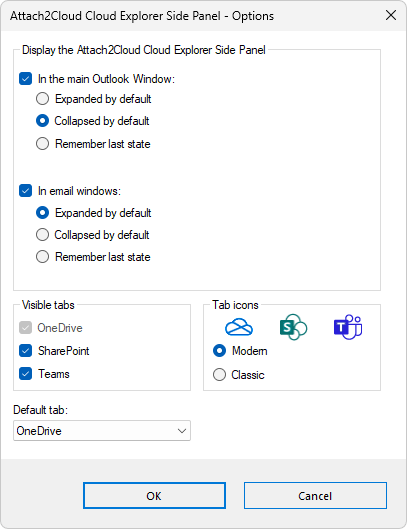
About the Cloud Explorer settings
Attach2Cloud Cloud Explorer side panel options
Specify the status of the Cloud Explorer side panel in the MS Outlook main window and in the email windows
The Cloud Explorer side panel can be set Visible or Hidden in the Main Outlook window and (independantly) in the MS Outlook message windows.
When visible it can be displayed collapsed or expanded by default, or restored to its last status (collapsed / expanded) at MS Outlook startup.
When the Cloud Explorer panel is hidden or has been closed by the user, it can be redisplayed by clicking the “Display Cloud Explorer Pane” button made available in the main MS Outlook window Attach2Cloud ribbon and in the MS Outlook message windows default Message ribbon (in the Attach2Cloud button group).
Hide or show the SharePoint Online and Teams tabs
If you do not use SharePoint Online or Teams, or if you prefer to keep the focus on OneDrive, you can hide the SharePoint Online and/or Teams tabs.
Choose between modern or classic tab icons
Set the style of the OneDrive, SharePoint Online and Teams tab icons, modern or classic.
Specify the Cloud Explorer default tab
Specify which Cloud Explorer tab (OneDrive, SharePoint Online or Teams) will be the selected one (displayed) at MS Outlook startup.
More about the Cloud Explorer for MS Outlook
More details
More details
The Cloud Explorer panel is available both in the main MS Outlook window and in the MS Outlook message windows
Based on Attach2Cloud settings, the Attach2cloud Cloud Explorer panel can be made available in the main MS Outlook window and in the MS Outlook message windows (independantly).
The Cloud Explorer panel can be collapsed or expanded or fully closed
Users can collapse or expand, or even close the Attach2Cloud Cloud Explorer side panel using the panel controls. Ribbon buttons are available (in the Main MS Outlook window Attach2Cloud ribbon and in the MS Outlook message windows in the default Message ribbon (Attach2Cloud button group) to redisplay the Cloud Explorer panel when it has been closed (or when it is configured not to be displayed at startup in one or the other MS Outlook window).
The Cloud Explorer panel is resizable
The Attach2Cloud Cloud Explorer panel width is resizable by the user. It remembers its current width, in the main MS Outlook window and message windows (independantly) when MS Outlook or the last MS Outlook message window is closed (or when the Cloud Explorer panel is collapsed or closed by the user) and restores it at next MS Outlook startup (or when the side panel is re-displayed or deployed).
The Cloud Explorer is one of the Attach2Cloud version 6 new features
The Cloud Explorer belongs to the version 6 of Attach2Cloud Enterprise. For existing Attach2Cloud customers, all the Attach2Cloud features you know remain fully available. The Cloud Explorer is an additional feature that comes on the top of the Attach2Cloud you know. There is a full ascending compatibility betwen the version 5 of Attach2Cloud and its new version 6.
Technically
Technicaly
Super fast - Zero MS Outlook slowdown
The Attach2Cloud Cloud Explorer is pure super-concise non-blocking C# code. No java, no javascript. It is light-speed fast code and has zero impact on MS Outlook speed. Outlook starts just as fast as usual and new MS Outlook message windows pops up just as fast as usual.
No local file synchronization needed
The Attach2Cloud Cloud Explorer side panel offers to Microsoft Outlook an online view on the MS 365 cloud storage spaces (OneDrive, SharePoint Online and Teams). It does not require (and does not implement) any local file synchronization of the cloud files. Only the names and paths of the cloud folders, sites and teams to which the user has access are cached in a local catalog.
